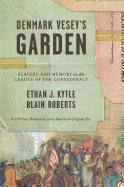
Denmark Vesey's Garden: Slavery and Memory in the Cradle of the Confederacy is vital to understanding some of the deepest fault lines in American life, made disturbingly relevant by Dylann Roof's 2015 murder of nine worshippers in a Charleston, S.C., church with "among the oldest black congregations in the South." Roof's actions were motivated, at least in part, by a deeply flawed understanding of slavery and the Civil War. Denmark Vesey's Garden seeks to trace rival memories of slavery in Charleston, the home of Denmark Vesey's failed slave uprising and the disembarkation point for "nearly half the slaves transported for sale in this country."
Historians Ethan J. Kytle and Blain Roberts begin by examining the massive wealth produced by Charleston's antebellum status as "slavery's capital." The first shots of the Civil War were fired at Fort Sumter, off the coast of Charleston, and South Carolinian secessionists were clear about the cause of the war: "The true question for us is, how shall we sustain African slavery in South Carolina...?" After the Confederate defeat, however, Charlestonians began to embrace a series of myths and rationalizations concerning slavery and the war that became known as the Lost Cause. After Reconstruction, the seeds of present-day controversy were planted in Charleston through the enthusiastic construction of Confederate monuments. Meanwhile, Charleston's black community held on to its own memories of slavery that contradicted myths such as the "happy slave." In an overview of the following century and more, the authors use the example of Charleston to explain why "Americans do not share a common memory of slavery." --Hank Stephenson, bookseller, Flyleaf Books, Chapel Hill, N.C.

